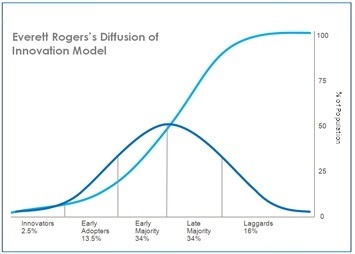Why Do Organisational Change Initiatives Overrun?
Post 2 of 4 in a series of articles on the subject of leading large-scale change in organisations.
The first post looked at the power and dangers of metaphors in leading change and suggested replacing the “burning platform” with the idea of a “High Noon moment”. This post looks at the dangers of underestimating how long it takes people to change and what you can do about it.
Change Initiative Overruns
In my experience, most change initiatives take longer – sometimes much longer – than leaders anticipated. The data backs this up. For example:
The Standish Group reported in 2004 that 71% of IT change projects overran their target timelines.
A 2012 report by the Saïd Business School at the University of Oxford showed that the typical project took on average 24% longer than expected. Note it said the “typical project”. Only 31% of the projects they studied were “typical”, meaning there’s a strong possibility that your next change project will overrun by much more than 24%.
So why is this?
Why Organisational Change Initiatives Overrun
Consultants have offered explanations like:
“There wasn’t enough dissatisfaction with the status quo – leaders hadn’t created a “burning platform”. Or instead the end state – the vision or goal – wasn’t compelling enough. Either way, people lacked motivation to change.”
“Leaders didn’t pay enough attention to project planning at the beginning. In particular, they didn’t test their starting assumptions, which later proved to be false.”
“Stakeholders outside the target change audience – e.g. shareholders, people higher in the hierarchy, politicians or whoever – weren’t fully behind the initiative’s aims and approach before it started.”
“Leaders allowed ‘mission creep’ to blur the boundaries of their project, causing loss of focus.”
“The projects didn’t make use of the best scheduling and planning tools.”
“Leaders didn’t track progress and adjust their plans as events unfolded.”
Now I’m not arguing with these insights, but I feel they omit the most important point of all: we don’t truly “get it” that change takes time, which often causes us to be ridiculously optimistic when setting timescales.
Why do I say this? Well, consider this question: what must happen if any organisational change is to succeed?
What Has To Happen?
The answer, simply put, is that people must collectively change their attitudes and start behaving differently.
Now hold that thought in mind as I bring in two perspectives from research that many change leaders overlook.
Outer Change Depends on Inner Transition
William Bridges, in his books, Transitions and Managing Transitions, described the three psychological phases that we all go through before we can accept a change: (1) Endings (2) the Neutral Zone (3) New Beginning.
In Endings , we struggle with losing something – or being about to lose something – we’ve become familiar and safe with. This could be our job through redundancy … or the way we used to do a job… or our spouse through death. In this phase you will often see denial, shock or anger. The significance of Endings is this: people have to accept that something is ending before they’ll begin to take the new idea on board.
In Neutral , we’re in an uncomfortable no-man’s-land where we know the old order has gone, but we haven’t accepted the new world. Feelings like frustration with new ways of working, confusion, uncertainty about our identity or self-worth, ambivalence and scepticism often reign.
In New Beginning , scepticism gives way to acceptance, openness to learning, hope, enthusiasm and renewed commitment to our group and role. Now we start behaving in ways that adapt to and support the outer change.
The big point is this: it takes time for all of us to move through these stages when we’re faced with change. This is a psychological fundamental that no leader can avoid.
“Okay, but so what,” you may be thinking?
Well, consider that leaders are usually further along this transition process than others in their organisation because they’ve been pondering on the change for longer. They often forget that it took them months or years to pass through the three phases and assume their colleagues should “get it” instantly – or within days of learning about the change idea.
Thus, they often underestimate the time needed to make the change happen. So guess what? The initiative overruns, but it’s not down to technical skill or a lack of “walking the talk”. It’s because they ignored a psychological reality.
Worse, they can assume that people in the “Ending” or “Neutral” zones are being uncooperative or resistant. This can cause leaders to make damaging decisions like firing people they need or ignoring intelligent objections. The point is this: if your change initiative doesn’t allow for the inevitable time delay in transitioning across the three stages, YOU could become the problem if you get irritated, behave foolishly and make rash decisions… and end up sabotaging the very change you wanted.
People Transition at Different Speeds
There’s a second factor that can magnify the first.
You see, not only do we all go through Bridges’ three phases, we move through them at different rates.
The first person to research this insight was Everett Rogers, who published his findings in his classic book, Diffusion of Innovations. He found that we can classify people’s attitude to innovation or change into five categories: (1) Innovators (2) Early Adopters (3) Early Majority (4) Late Majority (5) Laggards. He summarised his model in this diagram:
Rogers found that Innovators and Early Adopters – roughly 16% of the population – can move through the adoption cycle ten times faster than Laggards and about four times faster than the Majority (68% of the total).
In other words, not only do you have to accept the reality of the three-phase transition, you have to wait for most people to catch up with the change idea because less than 20% will respond quickly.
Admittedly, you can probably speed the adoption process by:
Making the change idea feel more attractive or more urgent.
Ensuring that the way you describe the change fits people’s values or sense of identity or habits or previous experiences.
Making it easier and more convenient to adopt (perhaps through training or providing the right tools).
Offering people a way to try out the change with minimal risk.
Ensuring that leaders are “walking the talk” and showing how important the change is.
Demonstrating early evidence – perhaps through quick wins – that the change is working.
But again, the fact is that people do vary in their attitudes to change, so if you adopt a one-size-fits-all attitude and believe everyone will grasp and accept the change instantly, you’ll be disappointed. Bottom line: your change initiative will take far longer than you expected.
“But We Don’t Have Time…”
Have you ever found yourself in high-pressure change situations where bosses have said something like, “But we don’t have time – it’s got to happen in XYZ timescale”?
I certainly have. And it can cause us to make unrealistic promises about how quickly the change will happen. But in my experience, it’s never true that we “don’t have time”. Unless the company is about to go bust or run out of cash, there is time. What they really mean is, their ego can’t wait. The trouble is, their ego is no match for psychological reality.
What Does This Mean?
I realise it isn’t easy to tell an egotistical boss that what they’re asking for is unrealistic. But it often is, and in my experience it’s better to tell them up front than have them find out six months or a year later.
The message is simple: you probably need to stretch your change timescale and plan accordingly, while making sure your stakeholders understand how long change takes. That way, no one’s disappointed and, more important, your frustration won’t spill over into irritation and foolish decisions.
Better to face the facts and plan accordingly, I suggest.
The author is James Scouller, an executive coach. His book, The Three Levels of Leadership: How to Develop Your Leadership Presence, Knowhow and Skill, was published in May 2011. You can learn more about it at www.three-levels-of-leadership.com. If you want to see its reviews, click here: leadership book reviews. If you want to know where to buy it, click HERE. You can read more about his executive coaching services at The Scouller Partnership’s website.




